|

August 2006
from
Antikythera-Mechanism Website
|
By T. Freeth1,2 , Y.
Bitsakis3,5 , X. Moussas3, J.H. Seiradakis4,
A.Tselikas5, E. Magkou6, M. Zafeiropoulou6,
R. Hadland7, D. Bate7, A. Ramsey7,
M. Allen7, A. Crawley7, P. Hockley7,
T. Malzbender8, D. Gelb8, W. Ambrisco9
and M.G. Edmunds1
-
Cardiff University,
School of Physics and Astronomy, Queens Buildings,
The Parade, Cardiff CF24 3AA, UK. Mike Edmunds
Mike.Edmunds @ astro.cf.ac.uk
-
Images First Ltd 10
Hereford Road, South Ealing, London W5 4SE, UK. Tony
Freeth tony @ imagesfirst.com
-
National &
Kapodistrian University of Athens, Department of
Astrophysics, Astronomy and Mechanics,
Panepistimiopolis, GR15783, Zographos, Greece.
Xenophon Moussas, xmoussas @ phys.uoa.gr
-
Aristotle University
of Thessaloniki, Department of Physics, Section of
Astrophysics, Astronomy and Mechanics, GR54124
Thessaloniki, Greece. John Seiradakis jhs @
astro.auth.gr
-
Centre for History and
Palaeography, National Bank of Greece Cultural
Foundation, P. Skouze 3, 10560 Athens, Greece. Yanis
Bitsakis bitsakis @ gmail.com
-
National
Archaeological Museum of Athens, 44 Patission Str,
106 82 Athens, Greece.
-
XTek Systems Ltd,
Tring Business Centre, Icknield Way, Tring, Herts
HP23 4JX, UK.
-
HewlettPackard
Laboratories, 1501 Page Mill Road, Palo Alto, CA
94304, USA.
-
Foxhollow Technologies
Inc., 740 Bay Road, Redwood City, CA 94063, USA.
|
The Antikythera Mechanism is a
unique Greek geared device, constructed around the end of the 2nd
Century BC.
From previous work1,2,3,4,5,6,7,8,9
it is known that it calculated and displayed celestial information,
particularly cycles such as the phases of the moon and a luni-solar
calendar. Calendars were important to ancient societies10 for timing
agricultural activity and fixing religious festivals. Eclipses and
planetary motions were often interpreted as omens, while the calm
regularity of the astronomical cycles must have been philosophically
attractive in an uncertain and violent world.
Named after its place of discovery in
1901 in a Roman shipwreck, the Mechanism is technically more complex
than any known device for at least a millennium afterwards. Its
specific functions have remained controversial11,12,13,14
because its gears and the inscriptions upon its faces are only
fragmentary. Here we report surface imaging and high-resolution
X-ray tomography of the surviving fragments, enabling us to
reconstruct the gear function and double the number of deciphered
inscriptions.
The Mechanism predicted lunar and solar
eclipses based on Babylonian arithmetic-progression cycles.
The inscriptions support suggestions of mechanical display of
planetary positions9,14,16, now lost. In the second
century BC, Hipparchos developed a theory to explain the
irregularities of the Moon's motion across the sky caused by its
elliptic orbit.
We find a mechanical realization of this
theory in the gearing of the Mechanism, revealing an unexpected
degree of technical sophistication for the period.
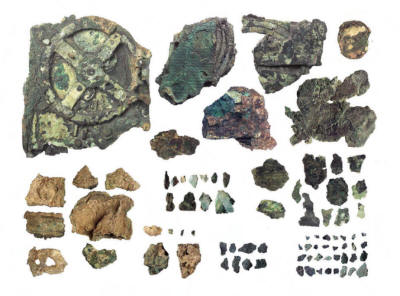
Figure 1:
The surviving fragments of
the Antikythera Mechanism. The 82 fragments that survive in the
National Archaeological Museum in Athens are shown to scale. A
key and dimensions are provided in Supplementary Notes 1
(Fragments).
The major fragments A, B,
C, D are across the top, starting at top left, with E, F, G
immediately below them. 27 hand-cut bronze gears are in fragment
A and one gear in each of fragments B, C and D. Segments of
display scales are in fragments B, C, E and F. A schematic
reconstruction is given in Figure 2.
It is not certain that every one of the remaining fragments
(numbered 175) belong to the Mechanism. The distinctive fragment
A, which contains most of the gears, is approximately 180 x 150
mm in size.
We have used three
principal techniques to investigate the structure and
inscriptions of the Antikythera Mechanism.
-
3-dimensional Xray microfocus computed
tomography17 (CT), developed by XTek Systems Ltd. The
use of CT has been crucial in making the text legible
just beneath the current surfaces.
-
Digital optical imaging to reveal faint
surface detail using Polynomial Texture Mapping
(PTM)18,19 , developed by Hewlett-Packard Inc.
-
Digitized high quality conventional film
photography.
The bronze Mechanism (Figure 1 above),
probably hand-driven, was originally housed in a wooden-framed case1
of (uncertain) overall size 340 x 180 x 90 mm.
It had front and back doors, with
astronomical inscriptions covering much of the exterior of the
Mechanism (Figure 2 below). Our new transcriptions and translations
of the Greek texts are given in Supplementary Notes 2 (Glyphs &
Inscriptions).
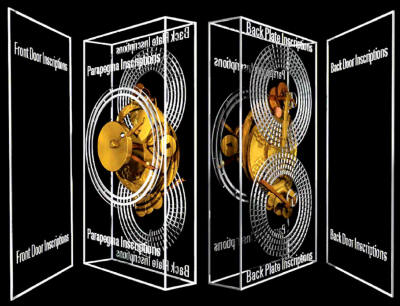
Figure 2:
A schematic view of the
Mechanism to illustrate the position of major inscriptions and
dials. The Front Dial has two concentric scales. The inner scale
shows the Greek Zodiac with 360 divisions.
There are occasional Greek
letters denoting references to the Parapegma inscription, and we
add three further reference letters (Z, H, Θ) to Price’s
description1. The Parapegma is a star almanac showing rising and
settings at dawn or evening of particular stars or
constellations, which we will discuss elsewhere. Its form is
consistent with a late 2nd Century BC date. The outer
(originally) movable scale is a Calendar carrying the Egyptian
names of the months with Greek letters.
The Egyptian Calendar of
365 days, with twelve 30day months and 5 extra (epagomenai) days
was in standard use in Greek astronomy. The effect of the extra
quarter day in a year could be corrected by turning the scale
one day every four years – and a sequence of holes to take a
locking pin is observed under the scale. We find that spacing of
the holes is indeed what would be expected for a total of 365
days, with a possible range 363365.
The position of the Sun and
Moon would have been indicated by pointers across the dial
scales, and a device7 showing the phase of the Moon was probably
carried round on the lunar pointer. It is not clear whether the
Sun position pointer would have been separated from a date
pointer, or whether any planetary positions might have been
displayed.
The spiral Upper Back Dial
displays the lunisolar Metonic sequence of 235 lunar months with
a subsidiary dial showing the Callippic cycle, while the spiral
Lower Back Dial displays the 223 lunar month Saros eclipse cycle
with a subsidiary dial showing the Exeligmos cycle.
The detailed form of the lettering can
be dated to the second half of the 2nd Century BC, implying that
that the Mechanism was constructed during the period 150-100 BC,
slightly earlier than previously suggested1.
This is consistent with a date of around
80-60 BC of the wreck1,20 from which the mechanism was
recovered by some of the first underwater archaeology. We are able
to complete the reconstruction1 of the Back Door inscription with
text from fragment E, and characters from fragments A and F.
The Front Door is mainly from
fragment G. The text is astronomical with many numbers that could be
related to planetary motions. The use of “sterigmos [ΣΤΗΡΙΓΜΟΣ] –
station or stationary point” means where a planet’s apparent motion
changes direction and the numbers may relate to planetary cycles.
The Back Door inscription mixes mechanical terms about
construction (“trunnions”, “gnomon”, “perforations”) with
astronomical periods.
Of the periods, 223 is the Saros eclipse
cycle (see 'Box' below for brief explanation of astronomical cycles
and periods).
|
Box
Astronomical
Cycles known to the Babylonians
The lunar (or synodic) month is the interval between the
Moon being at the same phase – e.g. full moon to full
moon. The Metonic Cycle results from the close equality
of 19 years to 235 lunar months. It represents the
return to the same phase of the Moon on the same date in
the year. After the Cycle the Sun, Moon and Earth are
back in nearly the same relative orientations.
The Moon appears to
return to the same point in the sky relative to the
zodiac in a sidereal month, and in 19 years there are
235 + 19 = 254 sidereal months. The 76year Callippic
Cycle is four Metonic Cycles minus one day and improves
the accuracy of reconciling solar years with whole
numbers of lunar months.
The Saros is an eclipse repeat cycle. If either a solar
or lunar eclipse occurs, a very similar eclipse will
occur 223 lunar months later21. A record of past
eclipses can thus be used to predict future occurrences.
The cycle arises from the coincidence of three orbital
periods of the Moon.
These are:
-
same phase to
same phase, 223 synodic months, eclipses will of
course only occur at new or full Moon in the month
-
the lunar
crossing of the EarthSun orbital plane, 242
draconitic months – eclipses can only occur near
these points (nodes) of coalignment
-
similar
EarthMoon distances which occur on the period from
apogee to apogee of the Moon’s orbit, 239
anomalistic months
The distance will
determine the magnitude of the eclipse, ensuring the
similarity of eclipses at the period of the cycle. The
Saros Cycle is not an integer number of days (6585�),
causing the eclipses in successive cycles to be
displaced by eight hours in time (and solar eclipses,
only visible at limited geographical locations, to be
displaced by 120˚ in longitude).
True repeats come
after 3 Saros cycles, the 54year Exeligmos cycle, but
not with identical solar eclipse paths. |
We discover the inscription “spiral
divided into 235 sections”, which is the key to understanding the
function6 of the Upper Back Dial. The references
to “golden little sphere” and “little sphere” probably refer to the
front zodiac display for the Sun and Moon – including phase for the
latter.
The text near the Lower Back Dial includes “Pharos” and “From
South (about/around)… Spain ten”. These geographical references,
together with previous readings1 of “Towards the East”,
“WestNorthWest” and “WestSouthWest” suggest an eclipse function for
the dial, since solar eclipses occur only at limited often recorded
22,23,24 geographical sites, and winds were in antiquity
with eclipse observations.
Possibly this information was added to
the Mechanism during use.
Turning to the dials themselves, the Front Dial displays the
position of the Sun and Moon in the Zodiac, and a corresponding
calendar1 of 365 days that could be adjusted for leap years.
Previously1, it was suggested that the Upper Back Dial
might have five concentric rings with 47 divisions per turn, showing
the 235 months of the 19year
Metonic Cycle. A later proposal
5 augments this with the Upper Subsidiary Dial showing the
76year
Callippic Cycle.
Our optical and CT imaging confirm these
proposals, with 34 scale markings discovered on the Upper Back
Dial. Based on a statistical analysis analogous to that
described for gear tooth counts below, we confirm the 235 total
divisions.
We also find from the CT that the
subsidiary dial is indeed divided into quadrants1,6, as
required for a Callippic Dial.
In agreement with the Back Door
inscription, we also substantiate the perceptive proposal5,25
that the dial is in fact a spiral, made from semicircular arcs
displaced to two centers on the vertical midline. In the CT of
fragment B we find a new feature that explains why the dial is a
spiral: a “PointerFollower” device (see Figure 3 below) traveled
around the spiral groove to indicate which month (across the five
turns of the scale) should be read.
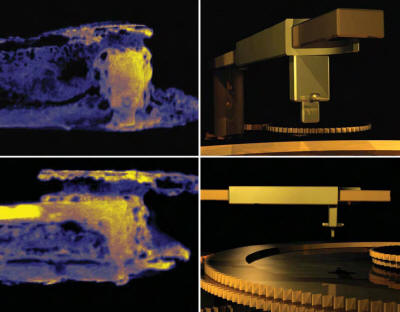
Figure 3:
The “pointer-follower”
lunar month indicator of the Upper Back Dial. On the left,
false-color sections through CT images, analyzed with VG-Studio
Max software by Volume Graphics GmbH.
These show two views at
right angles of the pointer-follower in the Metonic dial in
fragment B. On the right, a computer reconstruction of the
device from two different angles (with the Metonic scale omitted
for clarity). The pin was constrained to follow the groove
between the spiral scales (the scale is shown in Figure 4
below), causing the device to slide along the month pointer to
indicate which ring on the spiral scale specified the month. A
similar pointer-follower would have been present on the Lower
Back (Saros) Dial.
The Metonic dial would have
required resetting every 19 years, the Saros dial after 18
years. The groove-pin may have been held in place by the small
pin through the front of the device, enabling its removal for
resetting.
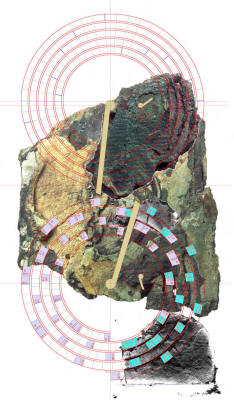
Figure 4:
Reconstruction of the Back
Dials. A composite of fragments A, B, E and F. The Metonic
Calendar is at top, with its subsidiary Callippic dial. The
Saros eclipse cycle is below, with its subsidiary Exeligmos
dial.
The 16 observed eclipse
glyphs are shown in turquoise on the Saros dial, with 35
hypothetical glyphs in violet. The hypothetical glyphs are based
on the criterion that 99% of the 121 sequences exactly matching
the observed glyphs have an eclipse at the month position. Both
main dials would have a “pointerfollower” (see Figure 3 above)
to indicate the relevant lunar month on the spiral.
The monthly divisions on
the Metonic Upper Back Dial are not simply scribed directly
across all five turns, as might be expected for simplicity of
construction. There are small misalignments, implying a
systematic attempt at marking full (30day) and hollow (29day)
months. The incomplete data does not allow good analysis, other
than a hint of bimodality in the interval distribution.
If the marking out of the
scale were carried out using the Mechanism’s gearing, then this
would greatly predate known “dividing engines”27 by many
centuries.
From our CT data of the 48 scale
divisions observed in fragments A, E and F, we establish 223
divisions in the fourturn5,25 spiral on the Lower Back
Dial, the spiral starting at the bottom of the dial.
This is the Saros eclipse cycle,
whose number is on the Back Door inscription. The 54-year
Exeligmos cycle of three Saros
cycles is shown on the Lower Subsidiary Dial.
Between the scale divisions of the Saros Dial we have identified 16
blocks of characters, or “glyphs” (see 'Glyphs & Inscriptions',
below) at intervals of one, five and six months.
Symbols (glyphs) in the
Saros spiral scale
Lunar Glyphs

Solar Glyphs

Lunar & Solar Glyphs

These are eclipse predictions and
contain either Σ for a lunar eclipse (from ΣΕΛΗΝΗ, Moon) or H for a
solar eclipse (from ΗΛΙΟΣ, Sun) or both.
A correlation analysis (analogous to DNA
sequence matching) with historic eclipse data26 indicates that over
a period of 400 – 1 BC the sequence of eclipses marked by the
identified glyphs would be exactly matched by 121 possible start
dates.
The matching only occurs if the lunar
month starts at first crescent and confirms this choice of month
start in the Mechanism.
The sequences of eclipses can then be
used to predict the expected position of glyphs on the whole dial,
as seen in Figure 4 far below. The dial starts and finishes
with an eclipse. Although Ptolemy indicates that the Greeks recorded
eclipses in the 2nd century BC, the Babylonian Saros Canon
22,23,24 is the only known source of sufficient data to
construct the dial.
The functions of the Mechanism are determined by the tooth counts of
the gears. These are based mainly on the CT, using angular
measurement from a nominal centre to the remains of tooth tips. In a
few cases all teeth can be seen, but many gears are incomplete.
Counts are established by fitting models with regularly spaced teeth
and minimizing the r.m.s. deviation from the measurements—varying
the centre in software (when unclear) to find the best-fit solution
or solutions.
We have adopted a systematic
nomenclature of lower case letters for the axis of the gear, with
numbering increasing with ordering from the front of the Mechanism.
Hypothetical (lost) gears are denoted by italics.
Several models have been proposed for the gear trains1,2,4,5,6,8.
We agree with the assumption of four missing gears (n1, n2, p1, p2)
to drive the Metonic and Callippic Dials 4.
We propose a new reconstruction for the
other trains, which uses all extant gears (except the lone r1 from
the separate fragment D). The proposed model is shown in Figure 5
below.
We require the assumption of only one
further gear (m3) whose proposed shaft is clearly broken off in the
CT.
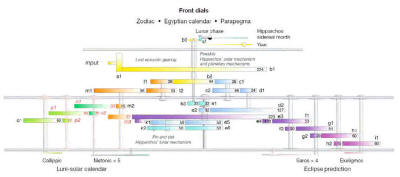
Figure 5:
New Reconstruction of the
Gear Trains. A schematic sectional diagram (not to scale) of the
gearing, following the style of Price1 and Wright4.
The viewpoint is looking down from the top right of the
Mechanism, and is stretched in the direction of the main axes to
show the structure.
Features that are outlined
or labeled in red are hypothetical. Gears are lettered with
their shaft, and numbered with increasing distance from the
Front Dial. The two-or-three digit number on the gear is its
actual or assumed tooth count (See Supplementary Notes 3 -
Gears). Hypothetical gears n1, n2, p1, p2 have been proposed
previously, the gear m3 on the broken-off shaft m is our
addition.
All gears, except the lone
one in fragment D, are now accounted for in the Mechanism. The
function of the trains is outlined in the text. We find no
evidence in the CT for an idler wheel carried on e3 and between
e5 and k1 or between k2 and e6, as has been previously proposed1,2,4.
The CT shows a pin through axis e between gears e1 and e2.
We believe its purpose is
to retain the square-bossed e1 on the shaft, but its passage
right through the axis rules out previous reconstructions1,2,4
where e1 and e2 were joined by an outer pipe rotating around the
shaft e.
Of particular note is the dual use of
the large gear, e3, at the back of the Mechanism, which has found no
use in previous models. In our model, it is powered by m3 as part of
a fixed-axis train that turns the Saros and Exeligmos Dials for
eclipse prediction and also doubles as the “epicyclic table” for the
gears k1, k2.
These are part of epicyclic gearing that
calculates the theory of the irregular motion of the moon, developed
by Hipparchos sometime between 146 and 128 BC28—the
“first anomaly”, caused by its elliptical orbit about the Earth. The
period of this anomaly is the period from apogee to apogee (the
anomalistic month). To realize this theory, the mean sidereal lunar
motion is first calculated by gears on axes c, d and e and this is
then fed into the epicyclic system.
As explained in Figure 6 below, a
pin-and-slot device on the epicyclic gears k1 and k2, clearly seen
in the CT, provides the variation.
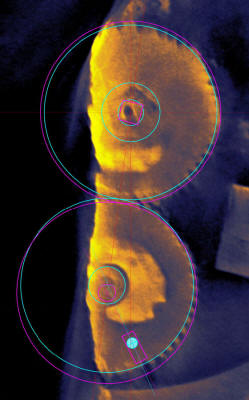
Figure 6:
The “Hipparchos” Lunar
Mechanism mounted on gear e3. The figure is based on a CT slice
of part of fragment A, showing (top) shaft e and (bottom) shaft
k. The complete geometry cannot be seen in a single CT slice.
The two gears on the e axis (e5 and e6) are coaxial, while the
two k gears rotate on slightly displaced axes. k1 has a pin on
its face that engages with a radial slot in k2 (and this was
previously reported5).
In the figure the pitch
circles of e5 and k1 are shown in turquoise and those of e6 and
k2 in pink. The gear e5 drives k1, which drives k2 via the
pin-and-slot introducing a quasi-sinusoidal variation in the
motion, which is then transmitted to e6. Our estimate of the
distance between the arbors on the k gears is about 1.1 mm, with
a pin distance of 9.6 mm, giving an angular variation of 6.5o.
According to Ptolemy15,
Hipparchos made two estimates for a lunar anomaly
parameter, based on eclipse data, which would require angular
variations of 5.9˚ or 4.5˚ here – although estimates of the
anomaly from Babylonian astronomy were generally larger. The
difference from our estimated value is probably not significant
given the difficulty of precise measurement of the axes in the
CT.
The harmonic variation,
together with the effect of carrying the gears on e3 which
rotates at the period of the Moon’s apogee around the Earth,
would simulate the correct variation for the Moon’s mean
(sidereal) rotation rate on the Front Dial. An (unexplained)
regular pentagon is visible at the centre of gear e5.
It is tempting to associate
the conception of the Mechanism with Hipparchos himself,
but he was not the first to assume eccentric or epicyclic
models.
This was previously identified4, but
rejected as a lunar mechanism.
The remarkable purpose of mounting the
pin-and-slot mechanism on the gear e3 is to change the period of
variation from sidereal month (i.e. the time taken for the Moon to
orbit the Earth relative to the zodiac), which would occur if k1 and
k2 were on fixed axes, to anomalistic month—by carrying the gears
epicyclically at a rate that is the difference between the rates of
the sidereal and anomalistic months, i.e. at the rate of rotation of
about 9 years of the Moon’s apogee.
Gears with 53-teeth are awkward to divide. So it may seem surprising
that the gearing includes two gears with 53 teeth (f1, l2), whose
effects cancel in the train leading to the Saros Dial. But the
gearing has been specifically designed so that the “epicyclic table”
e3 turns at the rate of rotation of the Moon’s apogee—the factor 53
being derived from the calculation of this rotation from the Metonic
and Saros cycles, which are the basis for all the prime factors in
the tooth counts of the gears.
The establishment of the 53 tooth count
of these gears is powerful confirmation of our proposed model of
Hipparchos’ lunar theory. The output of this complex system is
carried from e6 back through e3 and thence, via e1 and b3, to the
zodiac scale on the Front Dial and the lunar phase7
mechanism. Our CT confirms the complex structure of axis e that this
model entails.
A major aim of this investigation is to set up a data archive to
allow noninvasive future research, and access to this will start in
2007. Details will be available on
www.antikytheramechanism.gr.
The Antikythera Mechanism shows such great economy and
ingenuity of design.
It stands as a witness to the
extraordinary technological potential of Ancient Greece, apparently
lost within the Roman Empire.
Bibliography
1-Price, D. de S. Gears from the
Greeks: The Antikythera Mechanism — A Calendar Computer from ca.
80 BC, Trans Am. Philos. Soc., New Series, 64, Part 7 (reprinted
as Science History Publications, NY 1975), (1974)
2-Wright, M.T. Epicyclic Gearing and
the Antikythera Mechanism, Part I, Antiquarian Horology, Vol. 27
No. 3, pp. 270279, March (2003)
3-Wright, M.T., Bromley, A. G. and Magkou, E. Simple XRay
Tomography and the Antikythera Mechanism, PACT 45 (1995) ,
Proceedings of the conference Archaeometry in SouthEastern
Europe, pp. 531543, April (1991)
4-Wright, M.T. The Antikythera
Mechanism: a New Gearing Scheme. Bulletin of the Scientific
Instrument Society, No. 85, pp. 27, (2005)
5-Wright, M.T. Epicyclic gearing and the Antikythera Mechanism,
Part II. Antiquarian Horology, Vol. 29, No. 1, pp. 5163,
September (2005)
6-Wright, M.T. Counting Months and
Years: The Upper Back Dial of the Antikythera Mechanism.
Bulletin of the Scientific Instrument Society, No. 87, pp. 813,
(2005)
7-Wright, M.T. The Antikythera Mechanism and the Early History
of the MoonPhase Display, Antiquarian Horology, Volume 29, No.3,
March 2006, pp. 319329, (2006)
8-Wright, M.T. Understanding the
Antikythera Mechanism, Proceedings 2nd International
Conferenceon Ancient Greek Technology, Technical Chamber of
Greece, Athens, pp 4960, (2006)
9-Wright, M.T. A Planetarium Display
for the Antikythera Mechanism. Horological Journal, Volume 144,
No.5, pp. 169173; 144, No.6 p193 (2002)
10-North, J.D. The Fontana History
of Astronomy and Cosmology, Fontana Press, (1994)
11-Bromley, A. G. The Antikythera Mechanism, Horological
Journal, Vol 132, pp. 412415, (1990)
12-Bromley, A. G. Antikythera: An
AustralianMade Greek Icon!, Bassernet, Vol. 2, No. 3, June 1993,
Basser Department of Computer Science, University of Sydney,
(1993)
13-Freeth, T. The Antikythera Mechanism: 1. Challenging the
Classic Research, Mediterranean Archaeology & Decoding the
Antikythera Mechanism, published in Nature, Volume 444, Issue
7119, pp. 587-591 (2006). Archaeometry, Vol. 2 No. 1, pp. 2135,
(2002)
14-Edmunds, M. and Morgan, P. The Antikythera Mechanism: still a
mystery of Greek astronomy?, Astronomy & Geophysics, Vol. 41,
pp. 6.106.17, (2000)
15-Toomer, G. J. Ptolemy’s Almagest, translated by G. J. Toomer,
with a foreword by Owen Gingerich, Princeton University Press,
(1998)
16-Freeth, T. The Antikythera Mechanism: 2. Is it Posidonius’
Orrery?, Mediterranean Archaeology & Archaeometry, Vol. 2 No. 2,
pp. 4558, (2002)
17-XTek Systems Ltd, 3D Computed Tomography (2006). http://www.xtek.co.uk/ct/
18-Malzbender, T. and Gelb, D. Polynomial Texture Mapping,
HewlettPackard Mobile and Media Systems Laboratory, (2006).
http://www.hpl.hp.com/research/ptm/
19-Brooks, M. Tricks of the Light, New Scientist, No 2285, 7
April (2001)
20-Illsley, J.S. http://cma.soton.ac.uk/HistShip/shlect36.htm
21-Britton, J.P. Scientific Astronomy in PreSeleucid Babylon.
Chapter in H.D. Galter (ed.), Die Rolle der Astronomie in den
Kulturen Mesopotamiens. Graz, (1993)
22-Stephenson, F. R. Historical Eclipses and Earth’s Rotation,
Cambridge University Press, (1997)
23-Steele, J. M. Observations and Predictions of Eclipse Times
by Early Astronomers, Kluwer Academic Publishers, Dordrecht,
ISBN 0792362985, (2000)
24-Steele, J. M. Eclipse Prediction in Mesopotamia, Arch. Hist.
Exact Sci. 54, pp. 421454, (2000)
25-Wright, M.T. The Scholar, the Mechanic and the Antikythera
Mechanism. Bulletin of the Scientific Instrument Society, No.
80, pp. 411, (2003)
26-Espenak F. NASA’s website on eclipses developed by Fred
Espenak. All modern eclipse data and predictions in our work are
by Fred Espenak, NASA/GSFC (2005). http://sunearth.gsfc.nasa.gov/eclipse/eclipse.html
27-Chapman, A. Dividing the Circle, J.Wiley, Chichester, (1995)
28-Jones, A. The Adaptation of Babylonian Methods in Greek
Numerical Astronomy, Isis, Vol. 82, No. 3, pp. 440453, Sep
(1991)
|









